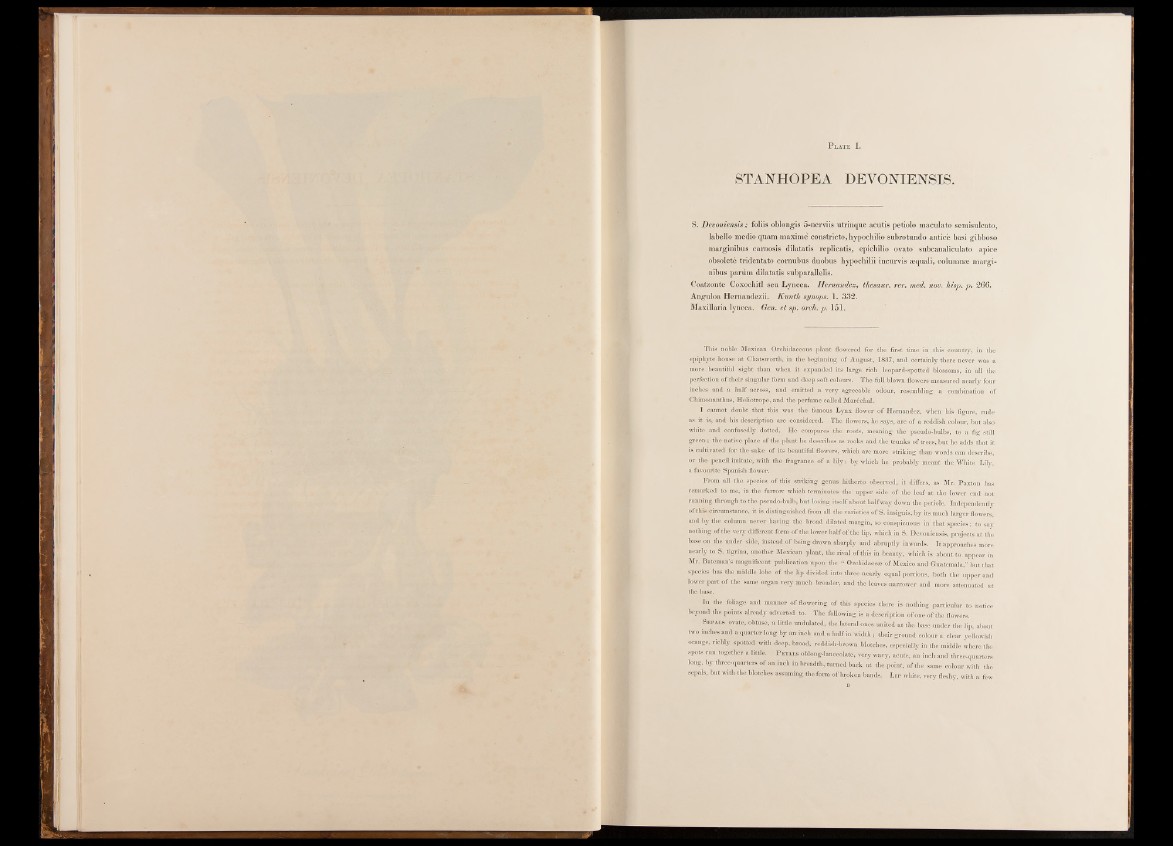
P late I.
STANHOPEA DEVONIENSIS.
S. Devoniensis; foliis oblongis 5-nerviis utrinque acutis petiolo maculato semisulcato,
labello medio quam maxime' constricto, hypochilio subrotundo antice basi gibboso
marginibus carnosis dilatatis replicatis, epichilio ovato subcanaliculato apice
obsolete tridentato cornubus duobus hypochilii incurvis aaquali, column« margi-
nibus parum dilatatis subparallelis.
Coatzonte Coxochitl seu Lyncea. Hernandez, thesaur. rer. med. nov. hisp. p. 266.
Anguloa Hernandezii. Kunth synops. 1. 332.
Maxillaria lyncea. Gen. et sp. orch. p. 151.
This noble Mexican Orchidaceous plant towered for the first time in this country, in the
epiphyte house at Chatsworth, in the beginning of August, 1837, and certainly there never was a
more beautiful sight than when it expanded its large rich leopard-spotted blossoms, in all the
perfection of their singular form and deep soft colours. The full blown towers measured nearly four
inches and a half across, and emitted, a very agreeable odour, resembling a combination- of
Chimonanthus, Heliotrope, and the perfume called Maréchal.
ï. I cannot doubt that this was the famous Lynx tower of Hernandez, when, his figure, rude
as it is; and his description are considered. The towers, he says,, are of a reddish colour, but also
white and confusedly dotted. He compares the roots, meaning the pseudo-bulbs, to a fig' still
green ; the native place of the plant he describes as rocks and the trunks of trees, but he adds that it
is cultivated for the sake of its beautiful towers, which are more striking than words can describe
or the pencil imitate, with the fragrance of a lily : by which he probably meant the White Lily,
a favourite Spanish tower..
From all the species of this striking genus hitherto observed, it differs, as Mr. Paxton has
remarked to me, in the furrow which terminates the upper side of the leaf at the lower end not
running through to the pseudo-bulb; but losing itself about half way down the petiole. Independently
of this circumstance, it is distinguished from all the varieties of S. insignis, by its much larger towers
and by the column never having the broad dilated margin, so conspicuous in that species ; to say
nothing of the very different form of the lower half of the lip, which in S. Devoniensis, projects at the
base on the under side, instead of being drawn sharply and abruptly inwards. It approaches more
nearly to S, tigrina, another Mexican plant, the rival of this in beauty, which is about to appear in
Mr. Bateman’s magnificent publication upon the “ Orchidaceæ of Mexico and Guatemala,” but that
species has the middle lobe of the lip divided into three nearly equal portions, both the upper and
lower part of the same organ very much broader, and the leaves narrower and moré attenuated at
the base.
In the foliage and maimer-ol flowering of this species there is nothing particular to; notice
beyond the points already adverted to. The following is a description of one of jhÿfldw A ,
S k ? a i.s ovate, obtuse," « litt> undulated, Unilateral ones united at the base under the lip, about
two inches and a quarter long by an inch and a half in width; their ground colonr a clear yellowish
orange, richly spotted with deep, broad, reddish-brown blotches, especially in the middle where the
spots ran together a little. P etals oblong-lanceolate, very wavy, acute, an inch and three-quarters
long, by three-quarters of an inch inbreadth, turned back at the point, of the same colour with the
sepals, but with the blotches assuming the form of broken bands. Lip white, very fleshy, with a few